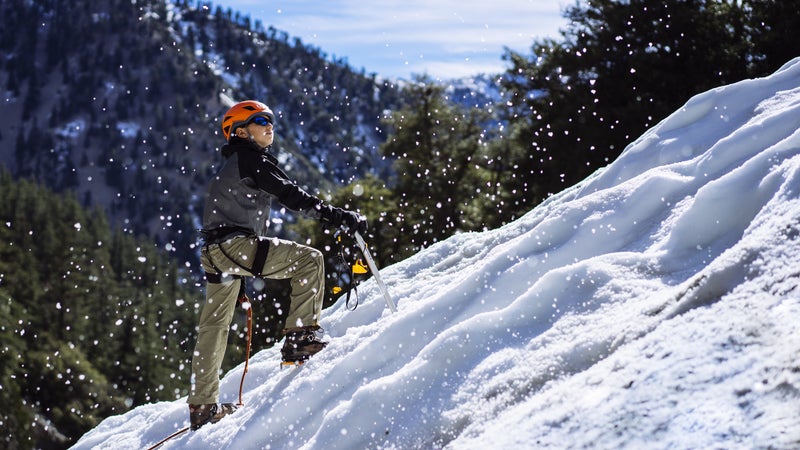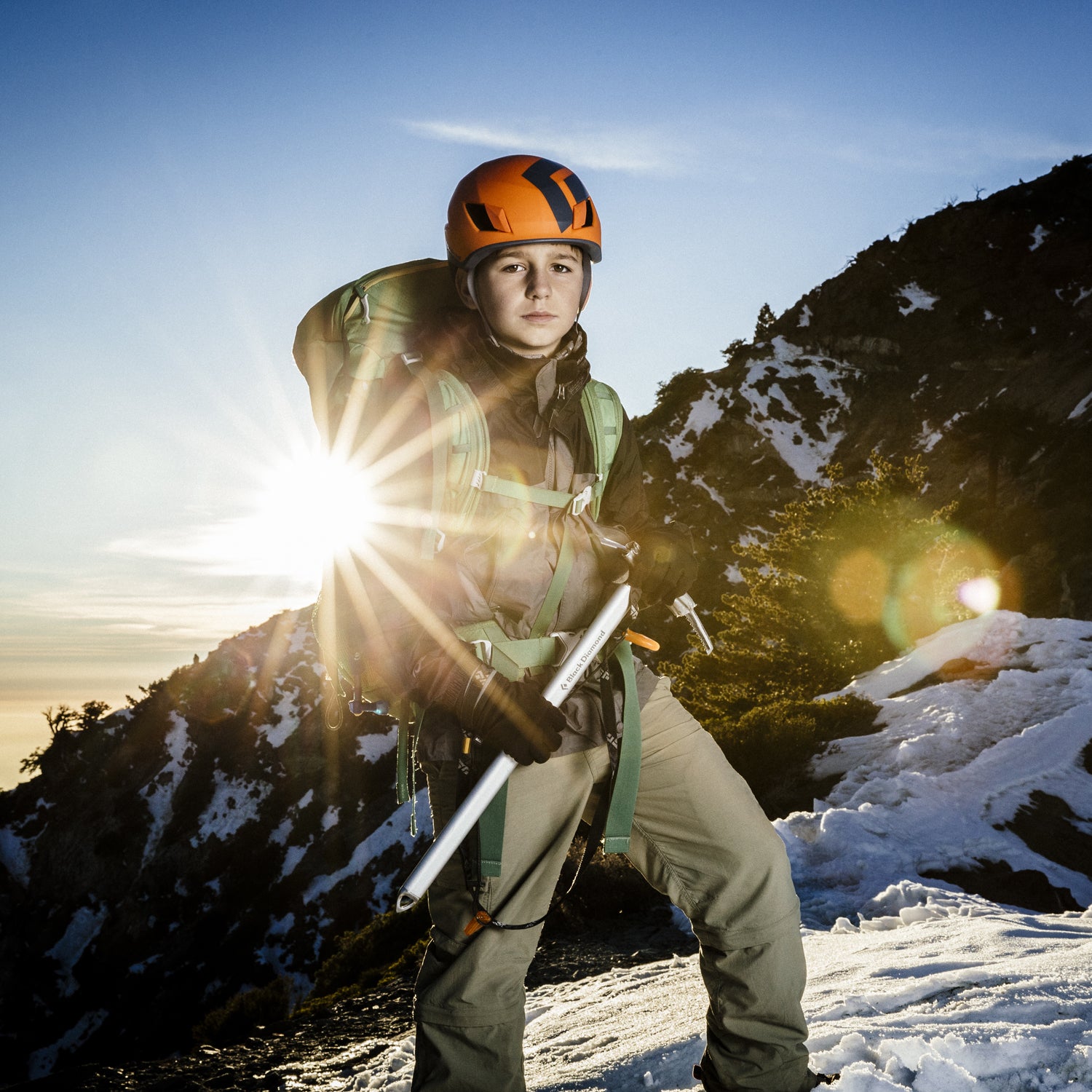In the three weeks since 11-year-old Tyler Armstrong announced his quest to become the youngest mountaineer to climb Mount Everest, the blogosphere and mainstream media have been abuzz with loud, predictable, controversy. Jon Krakauer gave Tyler a on HuffPost Live, calling his own 1996 ascent of Everest “the biggest mistake” of his life. On the German news��site Duetche Welle, noted high-altitude sports physician Thomas Kuepper cited higher incidences of frostbite and hypothermia among young climbers and .
As someone who believes fervently in introducing children to adventure at a young age and has been called out online for exposing my two young daughters to hazards in the backcountry, I try not to judge others' childrearing decisions. If I've learned anything, it's that as parents, we know our children's abilities, personalities, and appetite for challenge and adversity better than anyone. I've also learned that being an adventure parent doesn't mean ignoring risk or blindly denying fear. It means meeting both head-on, assessing them constantly, and being willing to back off if the circumstances, or our kids, demand it.
But try as I might, I just can't wrap my brain around sending a child up the highest mountain in the world. No matter how many risk variables you try to control, Everest has repeatedly proven dangerous and deadly—particularly in recent years. In April, 18 people at Base Camp died in an avalanche; last year 16 high-altitude workers were killed when an ice chunk dislodged on the way to Camp I. “If you haven't noticed, Everest has been having some pretty bad P.R. problems these past couple of years,” says veteran guide Dave Hahn, who has made 22 expeditions to the mountain and has summited 15 times.��

Even without the significant environmental disasters that have befallen the region recently, basic existence above 26,000 feet, in the so-called Death Zone, is enormously challenging. Throw in technical climbing, prolonged exposure to extreme alpine conditions, and Tyler's inexperience at that altitude, and the perplexing question that every Everest mountaineer since Hillary has asked themselves—why?—becomes why now? What's the big rush?
“I like pushing myself and I like to be different from other kids,” Tyler told me earlier this month, a few weeks before he starts sixth grade. I called to ask about his Everest plans, and I talked to him on speakerphone with his dad, Kevin. “I think I can push myself and be the youngest to do the Seven Summits. The recognition helps motivate me. It pushes me on the mountain.”
When it comes to mountaineering, Tyler has always been in a hurry. He began hiking near his southern California home when he was six. At seven, he became the youngest person��to hike Mount Whitney—22-mile hike along the class 1 —in a single day. “He did that with such ease, I couldn't believe it, and then he said he wanted to do something higher,” said Kevin, who has only recently gotten into mountain hiking because of Tyler's enthusiasm for it.
Tyler has so far achieved three of the Seven Summits, which represent the highest peak��on each continent: Aconcagua (South America), Kilimanjaro (Africa), and Mount Elbrus (Europe). Everest would be his fourth. He plans to tackle it next spring (he’ll be 12) via the Northeast Ridge, which means leaving from China. If he’s successful, he’ll break the record for the youngest person to summit Everest, set in 2010 by 13-year-old American Jordan Romero (also from California). Romero's climb was so controversial that the China Tibet Mountaineering Association subsequently announced it would not grant permits to climbers younger than 18 to ascend via the North Side, which presents a problem for Tyler.��
“There's something unique about Tyler's��ability to process oxygen,” says Kevin Armstrong.��“I don't believe it!”��Dave��Hahn laughed ruefully when I mentioned this to him. “But if he could only squeeze another ten-to-15 years of experience into his brain, that'd be wonderful!”
Age restrictions aren't unheard of in commercial guiding. In the Grand Canyon, most outfitters require that children be at least seven to raft the river's moderate rapids in the lower Canyon and 12 to tackle the burly class 10 whitewater in the Inner Gorge. Team Tyler is hoping for an exemption��when it comes to securing permits for his 2016 Everest expedition. Kevin declines to name his son's American guides, but told me in vague terms that “there is an indication that [the Chinese] will grant Tyler permission. He's not just a kid who says 'I want to climb Everest.' It's only because of his [mountaineering] record.” (However, Romero also had a stand-out record for his age, and it was his ascent that caused China to levy an age-limit in the first place.)
But seasoned mountaineers are quick to point out the blind spots in his resume: Denali, for one, a technical climb widely considered a litmus test for Himalayan ascents. “That would be a responsible way to go to Everest,” says Hahn. But Tyler hasn’t done it. In fact, he hasn’t climbed anywhere in the Himalayas or been above 23,000 feet. To prep for Everest, many mountaineers train on the 26,906-foot Cho Oyu, or another 8,000-meter Himalayan peak like Makalu. Sixteen-year-old American Matt Moniz climbed them both in 2014 and held the age record (12 years old) on Aconcagua until Tyler broke it at age nine. Moniz’s dad, Mike, says age is an important factor in climbing these peaks with success: “It's about a thoughtful progression, developing the skills and maturity to make sound judgments, so that if you are separated from your team—and it happens—you can get down the mountain on your own.”
Kevin insists that Tyler is up for the challenge. “He has professional guides training him. They say he's better than most adults.” According to Kevin, Tyler is versed in the technical elements of climbing and also possesses an uncanny physiological edge. “There's something unique about his ability to process oxygen. [No one] knows exactly why. We've measured the oxygen in his blood, and the higher up we went [in elevation], the more oxygen he had in his lungs. The guides couldn't believe it!” (“I don't believe it!” Hahn laughed ruefully when I mentioned this to him.��“But if he could only squeeze another ten-to-15 years of experience into his brain, that'd be wonderful!”)
As a precaution, Tyler will take supplemental oxygen with him and (if he’s allowed to climb) start using it lower on the mountain than most adult climbers. He’s also prepared to turn around if need be. “He's turned around 300 feet from the summit before,” on Whitney and on Mount Rainier, due to weather conditions, Kevin says. Plus, he adds, “Tyler is a child. He can't just say ‘No, I'm going anyway!'” (Kevin plans to hike Everest with Tyler but only as far as he is personally comfortable. It's possible that he would turn around and allow Tyler to continue.)
As for his training, Tyler says he’s doing two workouts a day. He’s also planning to summit the 19,342-foot Cotapaxi, in Ecuador, over Christmas break. There'll be time later for Alaska, Kevin says. “It was the guides who recommended he do Everest first. On Denali, he'd have to carry more weight and drag a sled. Strength-wise, he doesn't have that option. And since he's not going through the Khumbu Icefall, Everest isn't that technically challenging.”
“It was the guides who recommended he do Everest first,” says Kevin Armstrong. “Since he's not going through the Khumbu Icefall, Everest isn't that technically challenging.”
But Hahn paints a different picture. On two different occasions, he guided two girls, ages 16 and 17, up the North Side and failed to reach the top both times. “People think that because it doesn't have the Ice Fall that it's somehow just a hike,” he says. “It's not. There are significant vertical pitches on summit day. It can be more exposed to wind on the North Ridge. The North Side summit day starts at a higher camp, and sleeping that high can have difficulties of its own. It's a series of bottlenecks waiting to happen. It can be difficult to get a climber with a problem down quickly. You can do a lot of hours and still not get rid of 1,000 vertical feet and then your problems are always getting worse at 28,000 feet.”
For now, at least, Tyler and Kevin aren't dissuaded. “When I was listening to [Krakauer], I thought about his advice,” says Tyler. “But he doesn't know me.��He might have experienced different things than me. I don't suffer altitude sickness. I might have a better summit day. I might just do better than him.”
“As a parent, I don't criticize other people for their judgments,” says Kevin. “If Tyler had come to me without doing anything, I'd say heck no. Because he's done training and has the skills, it'd be hard to tell him no because of his age. It's not me saying he can do it. It's [the professional guides Tyler has been climbing with for three years] who have climbed the mountains. They're saying he can do it. There are so many pundits saying he has no business being there. I always say, 'Come out and go hiking with him.'”
I hope that if he goes, Tyler proves us all wrong. Who doesn't want to see kids go after their boldest objectives and achieve more than anyone thought possible? So many of us put our dreams on a back burner for a later date that never comes. Kids like Tyler remind us to keep chasing the dream, even when everyone around us says it can't or shouldn't be done. For his part, Romero is excited for Tyler. When asked what words of wisdom he would impart, he replied: “Everest is not the hardest mountain in the world, but there's no room for mistakes up there. You're 12 years old and you'll need to be prepared to face adult decisions, and life-threatening ones.”
Over the course of three candid conversations with Tyler and his dad, I have no doubt that Tyler's passion is his alone, not something his parents are foisting upon him. If anything, it's the other way around. “Tyler's taking me places in the world that I'd never thought I'd go,” says Kevin. “He's pushing me to do things.”
But just as our children teach us, we, too, must teach our children. This is what I keep coming back to, even as part of me—a big part—wants to root for Tyler and his outrageous plan. This is what gives me pause: Not that a 103-pound boy who still lives at home and hasn't finished going through puberty will scale a series of near-vertical ledges at 28,000 feet, above a 10,000-foot sheer drop.
The crux for me is that, as parents, we have to be the ones to make the tough calls, to listen to our own instincts and inner voices, not only those of paid professionals, so that our kids will learn the same. This one of our most important, and hardest jobs: to balance our children's irrepressible dreams with equal parts enthusiasm and prudence, to be the voice of patience even if they don't want to wait, and when we don't want to either. And finally, to teach our kids that our greatest—in Mike Moniz's words—”soul-building” accomplishments can't be quantified by age or speed��but by the deep and lasting confidence that wells up from within when you do what matters most to you, in your own time.


